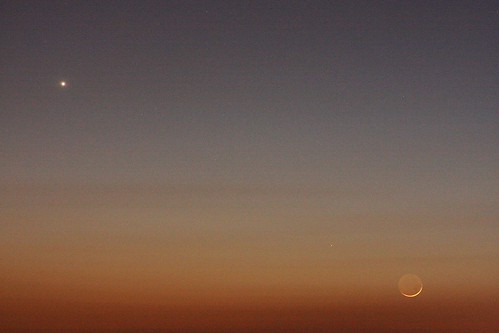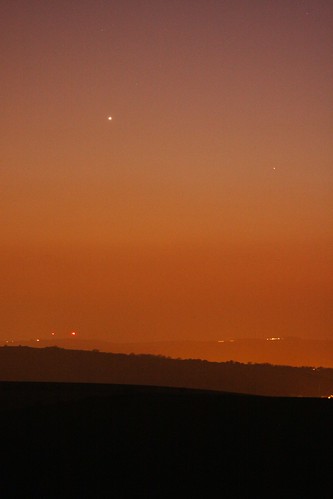It is now impossible to see the planet Mercury in the evening... Until it orbits around the Sun again. But I did manage to take the following photograph last Thursday, of a beautiful alignment of the Moon, Mercury and Venus.

It is now impossible to see the planet Mercury in the evening... Until it orbits around the Sun again. But I did manage to take the following photograph last Thursday, of a beautiful alignment of the Moon, Mercury and Venus.


Mercury orbits the Sun in just 88 days, and over the next week, you can see how quickly it moves in relation to Venus.
I took the photograph to the left on Monday the 12th April, at about 9pm, and you can see Mercury and Venus side by side (Venus is the bright object; Mercury the fainter object to the right of the image just slightly lower then Venus in the evening sky). But over the next week, as Mercury orbits around the Sun, it will rapidly move away from Venus to be in line with the Sun on the 28th of April.
So, if you want to see Mercury for yourself, the next few days would be a good time to look...
The next few weeks are an ideal time to see Mercury & Venus together in the evening sky.
Mercury is always a difficult planet to find. It is the closest planet to the Sun, and so it always remains close to the Sun in the sky, usually totally hidden in the Sun's glare. But at the beginning of April (as the simulation below shows), Mercury gets to its Greatest Eastern Elongation, meaning that it is as far away eastwards of the Sun as it is ever going to get, and so it is the best time to see Mercury in the evening sky.
So wait for the Sun to set, and then go out and see if you can see Mercury for yourself! The best days to look are the 15th and 16th of April, when the Moon acts as a useful guide. This will be your best chance to see the elusive Mercury!
Each frame in the simulation above is a view looking west when the Sun is 6 degrees below the horizon (about 40 minutes after sunset) - that's dark enough to see Venus and Mercury, but not so late that they are hidden behind trees. The simulation was done using Stellarium.
If you are wondering where Jupiter and Mercury are at the moment... they are hiding behind the Sun!
Below is a movie using data from the Lasco C3 insrtument on the NASA/ESA SOHO observatory, during February 2010. SOHO points constantly at the Sun, and so it allows us the see Venus, Jupiter and Mercury following their orbits around the far-side of the Sun.
It begins with Venus leaving the scene towards the left (which is why we can see it now in the evening sky), and then Jupiter moving left to right, and finally Mercury appearing!
Note that Lasco C3 is sensitive to 540nm-640nm wavebands, which is mid-green through to mid-red... so I've changed the usual blue colour to grey-scale (I think true colour would be a yellowish-brown...?).
Note also the 'bleeding' of the bright planets - they are so bright, that electrons over-flow into neighbouring cells on the Lasco-C3 CCDs. Note the the Sun is hidden behind a disk, to ensure that its brightness does not damage the camera.
Welcome to the Physics & Astronomy Outreach blog, part of the University of Sussex's P&A Outreach site.
This blog contains...
» Previews & reminders of up-and-coming outreach events & activities
» Reviews of past events
» Latest news in Physics & Astronomy - with special relevance to teaching, and the University of Sussex.
We hope you will enjoy reading the blog, and if you do have any ideas or suggestions, please do let us know via our contacts page.